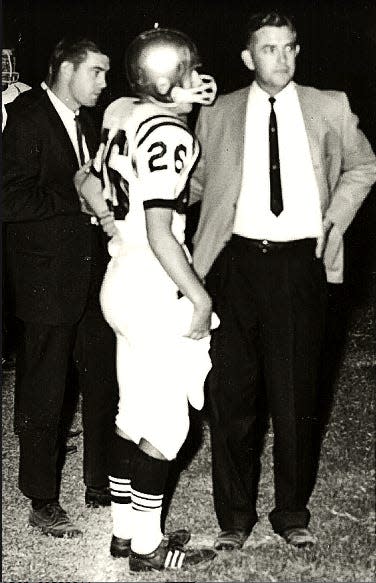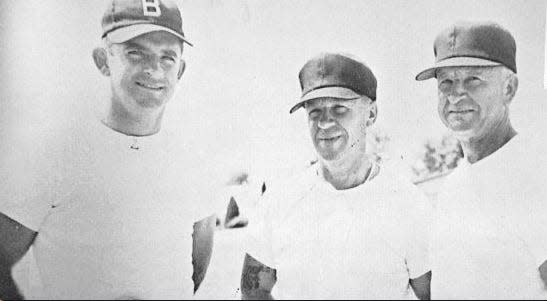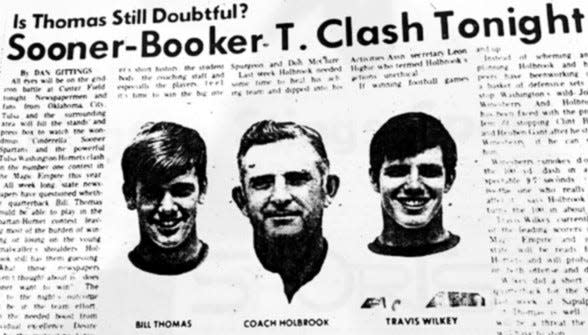Former Bartlesville coach Bill Holbrook stood at crossroads of local football history
BARTLESVILLE — The angular and powerfully built frame of Bill Holbrook stands alone at the crossroads of local high school football history.
He was the facilitator of the times that were a-changin' in the 1960s on the Bartlesville education landscape. He worked as the final head football coach at College High when it was the lone high school in town. And then he became the first head football coach at the newly-built Sooner High when it began varsity competition in 1967. He also served as Sooner's first athletic director.
Holbrook fathered the Spartan grid program and nurtured it with tender care and tough love for a decade.
In the late 1970s, Holbrook vanished from the Bartlesville scene and returned to the land of his roots and home of his heart, his beloved Lone Star State.

He lives there still, now age 98 and a widower of eight years after his wife Mary, his companion for 72 years, passed away.
As the 2023 high school season is just days away from opening practice, it's a good time to remember Holbrook. Especially since the Bartlesville Sports Commission is dusting off his legacy and polishing it up for Holbrook's induction this fall into the Bartlesville Athletic Hall of Fame. He is one of four individuals and a team in this year's Hall of Fame class.
The other impending inductees include former Phillips 66ers player and youth sports volunteer Lou Skurcenski, former state champion wrestler Clint Eads, former prep softball standout K.K McCoy and the 1990-91 Bartlesville High boys basketball team.
Bartlesville Sports Commission See the HOF Class of 2023 and past inductees since 2008
Holbrook is being enshrined as a coach.
"He was as big as life," said Bob Thomas, his Sooner quarterback in 1968 and 1969. "There was an aura about him. … He would make you work. He'd make you repeat things. On Tuesday, we'd be running the same play 15 times. (He) did what it took to find that other inch that let you gain three more yards."
As if Holbrook's impact on local prep football isn't enough, he's also the father of the Bartlesville High wrestling program, which he revved up in 1962 at Col-Hi.
Holbrook's task of helping the sports programs and fans of the two high schools exist was a mammoth Kissinger-esque feat. Consider that in warm-ups prior to the first-ever meeting (October 1967) between Col-Hi and Sooner, some Col-Hi fans (likely students) plastered Sooner players with eggs.
Perhaps the adversarial expressions changed somewhat during the next 14 seasons of Col-Hi and Sooner's edgy co-existence, but for many the emotions churned in a fragile shell.
It wasn't the first time in his life Holbrook had known conflict.
How Bill Holbrook became an influential figure in Bartlesville
The son of a Baptist preacher and carpenter, Holbrook first opened his eyes in October 1924 in Three Rivers, Texas.
Holbrook married at age 18 in 1942 and went off to war. He became a member of an airborne division in the European theater and twice parachuted behind enemy lines. In one of the missions, only he and two others survived out of a force of 27 men.
After the war ended in 1945, and before he was mustered home, he was chosen for his division football team — under the auspices of General Eisenhower — as a 187-pound All-Star tight end. He was the only player on the team without previous college or pro experience.
Holbrook returned home in 1946 and attended the University of Tulsa on a football scholarship. A 1947 Tulsa game program listed Holbrook as a 5-foot-11, 170-pound end not projected to start. In 1948, he started as a junior in the game against the University of Detroit.
With a diploma in hand, Holbrook arrived in 1950 in Bartlesville as a College High assistant football coach and educator. He labored doggedly and loyally for 12 years as an assistant for Burl Stidham, who in 2014 would be inducted into the BaHOF.

Another of his Wildcat assistant coaching colleagues in the 1950s was "Father" Bailey Ricketts, a BaHOF inductee in 2008. The '50s remain a golden era for local prep football:
Two future NFL All-Pro players (David Baker, 49ers; Bobby Joe Green, Bears) from the Class of 1955.
The opening of Custer Stadium for the 1954 season.
Several outstanding seasons (1950: 8-2; 1954: 8-2; 1957: 6-2-2; 1958: 9-1; and 1959: 7-1-2)
Col-Hi's record during Holbrook's 12 seasons as a Stidham assistant: 74-42-4.
In 1962, Holbrook succeeded Stidham as the Wildcats' head coach. His transfer to Sooner High reportedly was involuntary. But, the character-driven, real-life war hero jumped with both feet into the opportunity. There seems to be confusion about whether he joined the Sooner faculty in 1966 or 1967; the varsity football team began to play in 1967.
Holbrook notched 66 career wins (66-67-1) during his head coaching years at Col-Hi and Sooner. A handful of his former Sooner players maintain total respect for the man they never referred to by any other name but "Coach." Randy Standbridge felt Holbrook inspired him to get every ounce of potential out of his 135 pounds at defensive end.
"He was definitely a coach that prepared his team really well," Standbridge said.

Standbridge gave an example from the fall of 1971, as his Sooner Spartans prepared to play No. 1-ranked powerhouse Booker T. Washington and its sub-10-second sprinter at quarterback.
Standbridge referred to a recent conversation he had with Holbrook and quoted what his coach told him: "I told the coaches at the first of week, we were going to have the two ends … crack down on the quarterback as soon as he showed the option," Holbrook told Standbridge. "My assistants said let the ends cover the pitchmen instead. I gave in."
But, the altered strategy failed to stop the Hornets from scoring two touchdowns. Holbrook made a change during the game and told his ends to crash in on the quarterback — the Hornets didn't score another point as Washington held on to win, 12-7, on its way to capturing the state title.
In another signature game with even more emotional juice flowing through the veins, Sooner stunned its parent school Col-Hi, thanks to Holbrook's sharp mind for strategy. Prior to the showdown that season, Col-Hi had averaged more than 200 yards passing on its screen pass packages.
From the start of Monday practice that week, Holbrook "told us … we were not going to get beaten by screen plays," Thomas said. "By Friday, we knew them all in detail. They tried several. I was a defensive end and on two occasions almost smiled watching the play unfold and positioning myself in their backfield for the tackle and loss."
Sooner High won the game, but the next Monday he prodded Thomas for not making two potential interceptions.
"He wanted me to be better," Thomas said. "He had high expectations."
In 1968, Holbrook guided Sooner to a stunning 20-14 win against Col-Hi. Dale Bishop's pinball running for 133 yards, including a touchdown, fueled the Sooner offense.
Following his Sooner days, Holbrook returned for a couple of more years at Col-Hi. He had left town before the schools merged in 1982 to create Bartlesville High School. But, he had been there when needed in the late 1960s to help bridge the transition.
And, a good portion of the city will be there for him this October as he officially becomes a permanent part of local sports history.
This article originally appeared on Bartlesville Examiner-Enterprise: Bartlesville coaching legend Bill Holbrook headed to Hall of Fame
